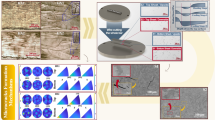Abstract
Selective laser melting (SLM) is a manufacturing technology that involves melting metal powder beds. Due to the temperature gradient during the course of forming, anisotropy is further caused by oriented grain growth. However, the influence of process parameters on anisotropy has not been studied. Two types of parameter scanning strategies and rotation angle increments were selected to alter the growth tendency of grains, thus affecting anisotropy. Comparing the STRIPES scanning strategy and the CHESS strategy, the latter can restrain anisotropy, while in the former, the anisotropy of tensile stress is influenced by the layer angle increment. The maximum tensile strength of SLM-formed parts in the formed direction deviates from an angle of 60° (1235 MPa and elongation of 5.3%), and the maximum microhardness property appears at the formed direction surface, namely, the top side surface (487 HV).






Similar content being viewed by others
Data availability
The data that support the findings in this paper are available from the corresponding authors upon reasonable request.
References
S. Wen, K. Chen, W. Li, Y. Zhou, Q. Wei, and Y. Shi, Mater. Des. 175, 107811. (2019).
T. Amine, C.S. Kriewall, and J.W. Newkirk, JOM 70, 384. (2018).
D. Kong, C. Dong, X. Ni, and X. Li, Npj Mater. Degrad. 3, 24. (2019).
W. Li, S. Li, J. Liu, A. Zhang, Y. Zhou, Q. Wei, C. Yan, and Y. Shi, Mater. Sci. Eng. A 663, 116. (2016).
G. Matsagopane, E.O. Olakanmi, A. Botes, and S. Kutua, JOM 71, 1840. (2019).
H. Shipley, D. McDonnell, M. Culleton, R. Coull, R. Lupoi, G. O’Donnell, and D. Trimble, Int. J. Mach. Tools Manuf. 128, 1. (2018).
B. Zhang, Y. Li, and Q. Bai, Chin. J. Mech. Eng. 30, 515. (2017).
J.R. Croteau, S. Griffiths, M.D. Rossell, C. Leinenbach, C. Kenel, V. Jansen, D.N. Seidman, D.C. Dunand, and N.Q. Vo, Acta Mater. 153, 35. (2018).
R. Ma, C. Peng, Z. Cai, R. Wang, Z. Zhou, X. Li, and X. Cao, J. Alloys Compd. 815, 152422. (2020).
H. Azizi, H. Zurob, B. Bose, S.R. Ghiaasiaan, X. Wang, S. Coulson, V. Duz, and A.B. Phillion, Addit. Manuf. 21, 529. (2018).
T. Maity, N. Chaweke, J.T. Kim, J. Eckert, and K.G. Prashanth, Manuf. Lett. 15, 33. (2018).
K.V. Yang, P. Rometsch, C.H.J. Davies, A. Huang, and X. Wu, Mater. Des. 154, 275. (2018).
Z. Chen, S. Chen, Z. Wei, L. Zhang, P. Wei, B. Lu, S. Zhang, and Y. Xiang, PNS: MI 28, 496. (2018).
J.P. Best, X. Mseder, J. Michler, and A.B. Spierings, Adv. Eng. Mater. 21, 1801113. (2018).
K. Kunze, T. Etter, J. Grasslin, and V. Shklover, Mater. Sci. Eng. A 620, 213. (2014).
T. Etter, K. Kunze, F. Geiger, and H. Meidani, IOP Conf. Ser. Mater. Sci. Eng. 82, 012097. (2015).
H. Zhang, D. Gu, L. Xi, H. Zhang, M. Xia, and C. Ma, J. Mater. Sci. Technol. 35, 1128. (2019).
Y. Yang, Y. Zhu, M.M. Khonsari, and H. Yang, Wear 428, 376. (2019).
F. Liu, H. Cheng, X. Yu, G. Yang, C. Huang, X. Lin, and J. Chen, Optics Laser Technol. 99, 342. (2018).
Y. Zhang, Y. Guo, Y. Chen, L. Kang, Y. Cao, H. Qi, and S. Yang, Metals 9, 1111. (2019).
Z. Zhang, B. Chu, L. Wang, and Z. Lu, J. Alloys Compd. 791, 166. (2019).
J.H. Robinson, I.R.T. Ashton, E. Jones, P. Fox, and C. Sutcliffe, Rapid Prototyp. J. 25, 289. (2019).
Y. Wang, C. Yu, L. Xing, K. Li, J. Chen, W. Liu, J. Ma, and Z. Shen, J. Mater. Process. Technol. 281, 116591. (2020).
Q. Liu, Y. Wang, H. Zheng, K. Tang, L. Ding, H. Li, and S. Gong, Mater. Sci. Eng. A 660, 24. (2016).
J. Han, M. Wu, Y. Ge, and J. Wu, Int. J. Adv. Manuf. Technol. 106, 1567. (2020).
S. Sun, K. Hagihara, and T. Nakano, Mater. Des. 140, 307. (2018).
L. Thijs, K. Kempen, J.P. Kruth, and J.V. Humbeeck, Acta Mater. 61, 1809. (2013).
D. Agius, K.I. Kourousis, C. Wallbrink, and T. Song, Mater. Sci. Eng. A 701, 85. (2017).
M. Wu, P. Lai, and J. Chen, Mater. Sci. Eng. A 650, 295. (2016).
W. Sun, Y. Ma, W. Huang, W. Zhang, and X. Qian, Int. J. Fatigue 130, 105260. (2020).
J. He, D. Li, W. Jiang, L. Ke, G. Qin, Y. Ye, Q. Qin, and D. Qiu, Materials 12, 321. https://doi.org/10.3390/ma12020321 (2019).
X. Miao, X. Liu, P. Lu, J. Han, W. Duan, and M. Wu, Metals 10, 1379. (2020).
D. Wang, S. Wu, Y. Yang, W. Dou, S. Deng, Z. Wang, and S. Li, Materials 11, 1821. (2018).
J. Akram, P. Chalavadi, D. Pal, and B. Stucker, Addit. Manuf. 21, 255. (2018).
Acknowledgements
This work was supported by the Fujian Insdustry-University Cooperation Project (Grant No. 2020 H6018) and Fujian Innovation Center of Additive Manufacturing (Grant No. ZCZZ20-04).
Author information
Authors and Affiliations
Corresponding author
Ethics declarations
Conflict of interest
The authors declare that they have no known competing financial interests or personal relationships that could have appeared to influence the work reported in this paper.
Additional information
Publisher's Note
Springer Nature remains neutral with regard to jurisdictional claims in published maps and institutional affiliations.
Supplementary Information
Below is the link to the electronic supplementary material.
Rights and permissions
About this article
Cite this article
Huang, W., Chen, X., Huang, X. et al. Anisotropic Study of Ti6Al4V Alloy Formed by Selective Laser Melting. JOM 73, 3804–3811 (2021). https://doi.org/10.1007/s11837-021-04765-0
Received:
Accepted:
Published:
Issue Date:
DOI: https://doi.org/10.1007/s11837-021-04765-0




